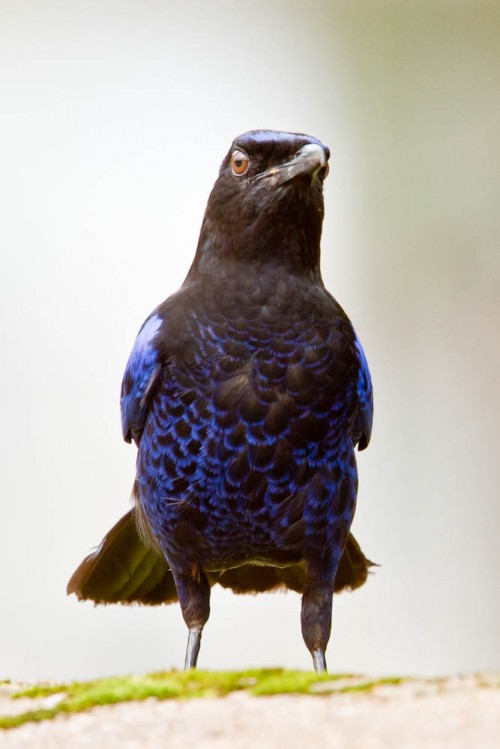
As there was a brief break from incessant downpour I wanted to get as much of photo opportunity as possible. I, with my family and my friends Dijiraj Nair and Shivashankar Nayak headed to Kudremukh National Park. I will show you few of the great shots we took in subsequent blogs. Afternoon following lunch at Kudremukh town we spotted a bold Malabar Whistling Thrush (Myophonus horsfieldii) sitting on a old metal gate and singing. While we all clicked at it using our big lenses it was singing without any hesitation and giving us great poses.
The Malabar Whistling Thrush (Myophonus horsfieldii) is a whistling thrush in the thrush family Turdidae. They are also known locally by the name of Whistling Schoolboy for the whistling calls that they make at dawn that have a very human quality. The species is a resident in the Western Ghats and associated hills of peninsular India including central India and parts of the Eastern Ghats.

This large thrush appears blackish with shiny patches of blue on the forehead and shoulders. The blue becomes visible only in oblique lighting. The bill and legs are black. The sexes are indistinguishable and juveniles are more brownish and lack the blue forehead.
The species is found all along the Western Ghats south of the Surat Dangs with some populations in Mt. Abu, Rajasthan. They are also found along the Satpura range to northwestern Orissa.

Malabar Whistling Thrushes are usually found in dark undergrowth and dense riverine forest. Half an our later we spotted another bird in the middle of the town and another female bird bathing nearby. We had great and extremely close look. I was trying Canon EF 300mm f/2.8 L IS USM with Canon EF 1.4x II Extender on Canon EOS 7D. Excitement of seeing bird at a such a close range, I had forgotten to check the auto focus setting of Canon EOS 7D. AI servo tracking sensitivity was turned too high. This resulted in the camera hunting focus when I try to focus in AI servo mode. Because of this I could get only few shots which were clearly in focus. I realized this mistake only the next day after seeing the photos. The “fast” tracking sensitivity setting means that when you’re shooting low, the camera will bounce a lot between the target and the background.
Quote taken from the canon site http://cpn.canon-europe.com/content/education/technical/eos_7D_custom_functions_explained.do
“The focus tracking sensitivity refers to how the camera responds and switches to another subject during focus tracking. This response sensitivity refers to how long the camera waits before switching to a new target subject when the current target subject escapes an AF point. It doesn’t adjust how quickly the autofocus tracks.”
Shiva who was equipped with Canon EF 500mm f/4 L IS USM Lens and much more experience in bird photography than me has captured the same birds excellently. Check his photos here – Malabar whistling thrush #1, Profile of whistler.., Portrait of whistler.. and Video of Whistler’s call. You can also check Diji’s capture using Canon EF 300mm f/4.0 L IS USM here.

They are omnivorous, eating a wide range of insects, crabs,frogs, earthworms and berries. They are usually seen singly or in pairs. This is a bold species and is often found close to human habitation. The male sings its varied and melodious whistling song from trees during summer. They may song for long early at dawn but at other times of the day they often utter sharp single or two note whistles. They were once popular as cage birds, with the ability to learn entire tunes. They bathe frequently in water usually in the mornings and evenings but at midday during hot weather.


Liked the Frontal View of Malabar Whistling Thrush and also the tail spread showing ‘an alarm pose’.
-Shiva
Really amazing Photos
Another great photo is in Shivanayak’s flickr photostream
http://www.flickr.com/photos/shivanayak/4789625619/
All of ’em are beautiful
-Sumit
Excellent… i like ur discription , pictures , knowledge..tfs
It’s a beautiful bird and its song is such a joy. Luck you for you to have seen and heard it at suchlike close quarters.